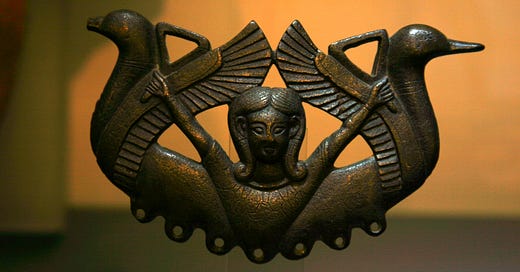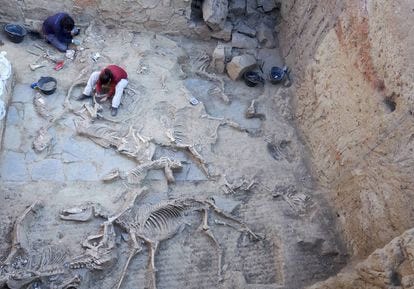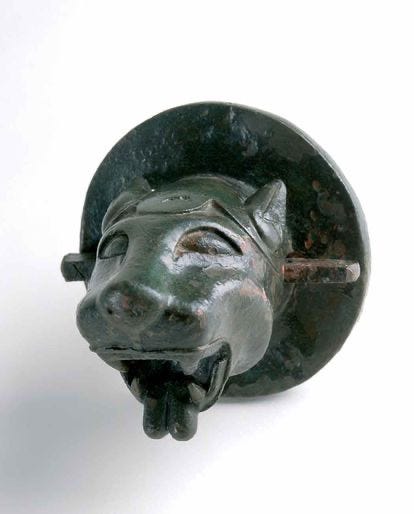Most people know that the Romans, Greeks, and Moors once occupied southern Spain, taking their turns through the millennia, passing this rich land from one culture to the next. Fewer know that the Phoenicians, Carthaginians, Visigoths and the Vandals also ruled parts of Andalusia for time periods, each bringing their language, arts, science and world views with them, slowly evolving the Andalusian culture, making it what it is today — a warm, welcoming and dizzyingly diverse region.
Far fewer know that this land was also inhabited by the Tartessian people for about 500 years, from the 9th to the 5th centuries BCE, a time known as the Bronze Age. Since this was a very long time ago, there’s a lot we don’t know about the Tartessians, but historians have decoded some of the mystery from the things they left behind. Scholars know, for example, that the Tartessians were a rich and clever people, so much so that Greek historians were impressed by them and recorded these observations. We know the Tartessians had their own language and writing system, because there are well preserved stones such as the Tartessian Fonte Velha, an inscription found in Southern Portugal that includes 80 of the 82 known writing signs in this pre-Hispanic, pre-Roman language.
Much of what is know about this culture comes from a dig site in Extremadura, Spain, where 2,500 years ago, in the municipality of Guareña in Spain’s Badajoz province, a group of Tartessian people gathered in an enormous two-story stone building for a ritual ceremony and banquet during which they sacrificed around many tens of valuable animals, including pairs of horses. The sacrificed animals found so far include the remains of 22 horses, three cows, two pigs, two sheep and one donkey, and there will be many, many more as this excavation progresses, which makes this site the largest example of animal blood letting ever found in the Mediterranean region.
After this heady multi-day ceremony, the participants set fire to the building and thoroughly buried the remains. This site is currently being explored by a team of archeologists who have benefited from a unique mix of ash and clay at the site, which has left much of the remains remarkably well preserved. Work started in 2015 at the site and the team believes it is only about 10% finished with the excavation, a long and painstaking process that involves carefully removing layers of clay, ash, stone and dirt to reveal fossils and other objects.
Archeologists are particularly intrigued about why the Tartessians would sacrifice horses, which symbolized their abundance and distinction. Some of the remains were found arranged theatrically in pairs, with their heads entwined. Before the massive fire that ironically preserved all of this, the Tartessian people also sacrificed some of their most valuable possessions: sacks of grains, intricate goblets and decorative bronze objects.
Sebastian Celestino, a member of the archeology team at the site, says that this sacrifice of valuable possessions suggests that the people here believed they had incurred the wrath of the gods and were trying to remedy the situation by partaking in this ritual ceremony. Little is known about the religion of the Tartessians, but historians assume they were, like for other Mediterranean peoples, polytheistic. It is believed that Tartessians worshiped the goddess Astarte or Potnia and the masculine divinity Baal or Melkart, as a result of the Phoenician acculturation.
There are many theories about the reason for the downfall of the Tartessian world. Until recently, many researchers hypothesized that their decline was largely due to brutal Celtic invasions from the north. But the Badajoz site lacks the telltale signs of war and defensive actions. There are no weapons and the Tartessos would not have spent the time required by bury such an enormous site if they were being invaded. New theories suggest that perhaps there was a natural disaster of some kind, a change in the climate, or perhaps an epidemic that ravaged the population. All we really know for sure is that the Tartessians abandoned many of their most sacred sites — perhaps all of them — at the same time. Another hint may lie in the fact that the King of Tartessos, Arganthonios — who reigned for 80 years according to Greek historian Herodotus — died at age 120 in the year 545 BCE. Could this leader’s death have somehow triggered the demise of his culture?
As scientists have begun going over the intimidating amount of ancient animals remains, they’re already found strange paradoxes. A horse remain appears to have had its hooves removed before sacrifice. A pig is missing a rib, which could have been eaten at the banquet before sacrifice. A donkey has a strangely enlarged head. Scientists also suspect they’ve found the first garment made of wool on the Iberian Peninsula, which suggests that the Tartessians were really quite sophisticated.
Archeologists have unearthed a room filled with jewels, pottery, seeds, bronze grates and an exquisitely preserved cauldron, its use unknown. Another vast room holds a typical Tartessian adobe altar with a bull hide and a strange bathtub/coffin. There’s also a three-meter high staircase made from a kind of cement that predated the Romans’ use of concrete by a century, which leads into the courtyard where the animals were found.
Other Tartessian sites around Andalusia are being lost or threatened by development, including the Cabezo de La Joya in Huelva. At this site, which is a small hill along the river Guadalquivir, the first excavations were carried out in the 1960s, resulting in the discovery of dozens of tombs filled with trousseaus of gold, silver and jewels, an ancient hearse, ceramics and even an Egyptian ivory chest featuring four figurines. The items are so rare and pristine that they went on display in some of the world’s most well known museums, including at the Met in New York. Built between the 8th and 6th centuries BCE, the modern city of Huelva, thought to be the Tartessian cultural capital, contains many other cabezos, all used by this ancient people. In the site, objects have been found that indicated the Tartessos people traded with peoples are far as the Middle East, and decorative objects were influenced by far flung styles and cultures, suggesting a wide ranging empire that often traveled beyond Iberia.
The Badajoz site one of the most exciting archeological digs in the world today, and 90% of its secrets and treasures remain underground, undiscovered. It seems that the semi-mythical Tartessos have many more mysteries to reveal, if only present day Andalusians get it together to preserve the sites for archeologists to explore and document.
Was it an epidemic or a climate disaster that triggered the downfall of a technologically advanced and wealthy people? We may never know, or if we’re following in the Tartessians’ gruesome path. History is often difficult to see in the present. And even more difficult to decipher 2,500 years later.
Follow me for more stories on culture, language, travel and change. And follow me on Instagram if you’d like.









